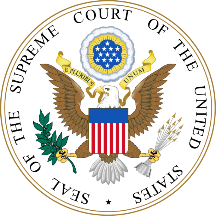

Judicial Branch
The Supreme Court is the highest court in the country. The Supreme Court heads the Judicial Branch of the United States government. It is the only court established by the Constitution. Decisions made by the Supreme Court are usually of national importance. "Equal Justice under Law" is the motto of the Supreme Court. When questions concerning particular laws arise in lower courts, the justices who make up the Supreme Court are responsible for explaining and interpreting the Constitution.
Make-Up:
The chief justice of the United States presides over the Supreme Court. The eight associate justices and the chief justice are nominated by the president and confirmed by the Senate. There are more than one hundred federal courts but only one Supreme Court, and its position at the top of the judicial system gives the Supreme Court unparalleled importance.
The lowest federal courts are the district courts. There are more than ninety federal district courts altogether—at least one in every state and as many as four in some states. District court judges, who number about seven hundred in all, are appointed by the president with the consent of the Senate. District courts are the only courts in the federal system in which juries hear testimony.
The United States has thirteen courts of appeals, each of which serves a “circuit” comprised of between three and nine states. These appellate courts are the second level of the federal court system. Each case is usually heard by a panel of three judges. Courts of appeals offer the only real hope of reversal for many appellants, because the Supreme Court hears so few cases.
The federal judiciary includes a few specialty courts. Among them are the U.S. Claims Court, U.S. Court of International Trade, U.S. Customs Office, and the U.S. Court of Military Appeals.
Selection of Federal Judges:
All federal judges are appointed. The Constitution states that the president appoints the justices of the Supreme Court with the advice and consent of the Senate. Congress has provided the same procedure for staffing other federal courts. This means that the Senate and the president jointly decide who will fill every vacant judicial position, no matter what the level.
Once a person is appointed as a federal judge they hold this position for life. Judges serve until they resign, retire voluntary, or die. Federal judges who engage in blatantly illegal conduct may be removed through impeachment, although such action is rare.
Powers of the Judicial Branch:
The judiciary’s power is most evident when it declares executive or legislative action to be unconstitutional. The power of the courts to make such determinations, called judicial review, was first asserted in the landmark Marbury v. Madison case of 1803, when the Supreme Court rebuked both the president and Congress.
Without judicial review, the federal courts would be unable to restrain an elected official or institution that has gone out of control.
The power given to courts to interpret the law is called jurisdiction. The jurisdiction granted to the judicial branch is limited to federal and constitutional laws. The federal courts hear cases where a person or group disobeyed the constitution, violated a treaty, committed a crime on federal property, or broke a federal law. They also hear cases when a citizen from one state sues a citizen of another state. The federal courts also hear cases when a foreign country accuses a government official or U.S. citizen of a crime against their nation, or a person commits a crime on a U.S. ship at sea.